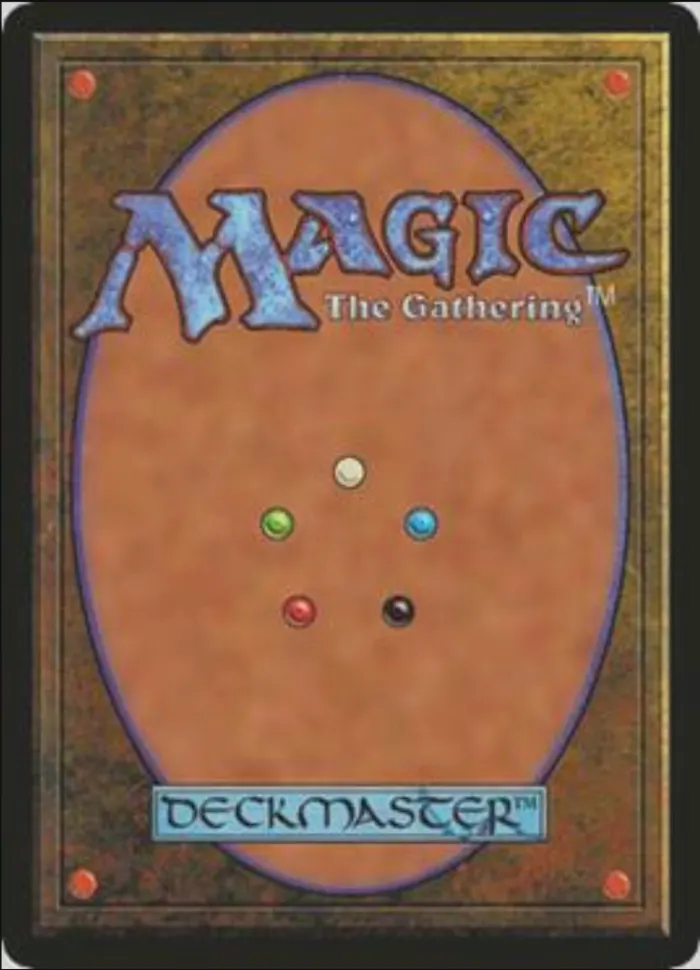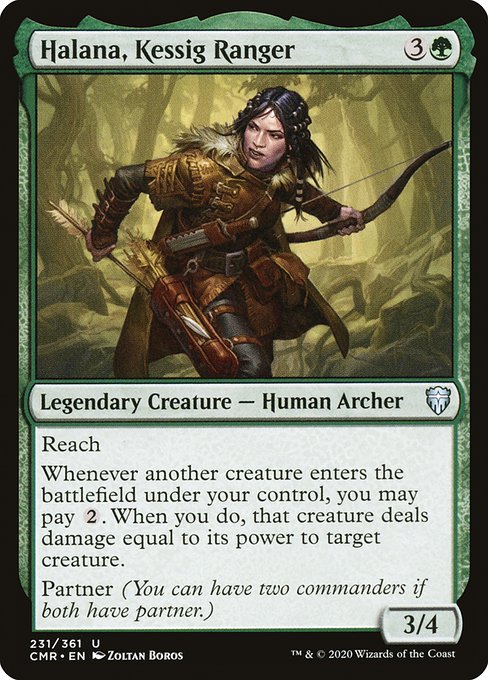Halana, ranger de Kessig
Créature légendaire : humain et archer
Portée
À chaque fois qu'une autre créature arrive sur le champ de bataille sous votre contrôle, vous pouvez payer . Quand vous faites ainsi, cette créature inflige un nombre de blessures égal à sa force à une créature ciblée.
Partenariat (Vous pouvez avoir deux commandants si les deux ont le partenariat.)
À chaque fois qu'une autre créature arrive sur le champ de bataille sous votre contrôle, vous pouvez payer . Quand vous faites ainsi, cette créature inflige un nombre de blessures égal à sa force à une créature ciblée.
Partenariat (Vous pouvez avoir deux commandants si les deux ont le partenariat.)
3/4
standard
future
historic
gladiator
pioneer
explorer
modern
legacy
pauper
vintage
penny
commander
brawl
alchemy
paupercommander
duel
oldschool
premodern
Rulings
An effect that checks whether you control your commander is satisfied if you control one or both of your two commanders.
Halana, Kessig Ranger’s triggered ability goes on the stack without a target. While that ability is resolving, you may pay . If you do, a second ability triggers and you pick a target that will be dealt damage. This is different from abilities that say “If you do . . .” in that players may cast spells and activate abilities after mana is paid but before damage is dealt.
If your Commander deck has two commanders, you can only include cards whose own color identities are also found in your commanders’ combined color identities. If Falthis and Kediss are your commanders, your deck may contain cards with black and/or red in their color identity, but not cards with green, white, or blue.
You can choose two commanders with partner that are the same color or colors. In Commander Draft, you can even choose two of the same commander with partner if you drafted them. If you do this, make sure you keep the number of times you’ve cast each from the command zone clear for “commander tax” purposes.
Once the game begins, your two commanders are tracked separately. If you cast one, you won’t have to pay an additional the first time you cast the other. A player loses the game after having been dealt 21 damage from any one of them, not from both of them combined.
For the creature that entered the battlefield, use its power as Halana’s reflexive triggered ability resolves to determine how much damage is dealt. If it’s no longer on the battlefield at that time, use its power as it last existed on the battlefield.
Both commanders start in the command zone, and the remaining 98 cards (or 58 cards in a Commander Draft game) of your deck are shuffled to become your library.
If something refers to your commander while you have two commanders, it refers to one of them of your choice. If you are instructed to perform an action on your commander (e.g. put it from the command zone into your hand due to Command Beacon), you choose one of your commanders at the time the effect happens.
To have two commanders, both must have the partner ability as the game begins. Losing the ability during the game doesn’t cause either to cease to be your commander.
Halana, Kessig Ranger’s triggered ability goes on the stack without a target. While that ability is resolving, you may pay . If you do, a second ability triggers and you pick a target that will be dealt damage. This is different from abilities that say “If you do . . .” in that players may cast spells and activate abilities after mana is paid but before damage is dealt.
If your Commander deck has two commanders, you can only include cards whose own color identities are also found in your commanders’ combined color identities. If Falthis and Kediss are your commanders, your deck may contain cards with black and/or red in their color identity, but not cards with green, white, or blue.
You can choose two commanders with partner that are the same color or colors. In Commander Draft, you can even choose two of the same commander with partner if you drafted them. If you do this, make sure you keep the number of times you’ve cast each from the command zone clear for “commander tax” purposes.
Once the game begins, your two commanders are tracked separately. If you cast one, you won’t have to pay an additional the first time you cast the other. A player loses the game after having been dealt 21 damage from any one of them, not from both of them combined.
For the creature that entered the battlefield, use its power as Halana’s reflexive triggered ability resolves to determine how much damage is dealt. If it’s no longer on the battlefield at that time, use its power as it last existed on the battlefield.
Both commanders start in the command zone, and the remaining 98 cards (or 58 cards in a Commander Draft game) of your deck are shuffled to become your library.
If something refers to your commander while you have two commanders, it refers to one of them of your choice. If you are instructed to perform an action on your commander (e.g. put it from the command zone into your hand due to Command Beacon), you choose one of your commanders at the time the effect happens.
To have two commanders, both must have the partner ability as the game begins. Losing the ability during the game doesn’t cause either to cease to be your commander.
Rulings
An effect that checks whether you control your commander is satisfied if you control one or both of your two commanders.
Halana, Kessig Ranger’s triggered ability goes on the stack without a target. While that ability is resolving, you may pay . If you do, a second ability triggers and you pick a target that will be dealt damage. This is different from abilities that say “If you do . . .” in that players may cast spells and activate abilities after mana is paid but before damage is dealt.
If your Commander deck has two commanders, you can only include cards whose own color identities are also found in your commanders’ combined color identities. If Falthis and Kediss are your commanders, your deck may contain cards with black and/or red in their color identity, but not cards with green, white, or blue.
You can choose two commanders with partner that are the same color or colors. In Commander Draft, you can even choose two of the same commander with partner if you drafted them. If you do this, make sure you keep the number of times you’ve cast each from the command zone clear for “commander tax” purposes.
Once the game begins, your two commanders are tracked separately. If you cast one, you won’t have to pay an additional the first time you cast the other. A player loses the game after having been dealt 21 damage from any one of them, not from both of them combined.
For the creature that entered the battlefield, use its power as Halana’s reflexive triggered ability resolves to determine how much damage is dealt. If it’s no longer on the battlefield at that time, use its power as it last existed on the battlefield.
Both commanders start in the command zone, and the remaining 98 cards (or 58 cards in a Commander Draft game) of your deck are shuffled to become your library.
If something refers to your commander while you have two commanders, it refers to one of them of your choice. If you are instructed to perform an action on your commander (e.g. put it from the command zone into your hand due to Command Beacon), you choose one of your commanders at the time the effect happens.
To have two commanders, both must have the partner ability as the game begins. Losing the ability during the game doesn’t cause either to cease to be your commander.
Halana, Kessig Ranger’s triggered ability goes on the stack without a target. While that ability is resolving, you may pay . If you do, a second ability triggers and you pick a target that will be dealt damage. This is different from abilities that say “If you do . . .” in that players may cast spells and activate abilities after mana is paid but before damage is dealt.
If your Commander deck has two commanders, you can only include cards whose own color identities are also found in your commanders’ combined color identities. If Falthis and Kediss are your commanders, your deck may contain cards with black and/or red in their color identity, but not cards with green, white, or blue.
You can choose two commanders with partner that are the same color or colors. In Commander Draft, you can even choose two of the same commander with partner if you drafted them. If you do this, make sure you keep the number of times you’ve cast each from the command zone clear for “commander tax” purposes.
Once the game begins, your two commanders are tracked separately. If you cast one, you won’t have to pay an additional the first time you cast the other. A player loses the game after having been dealt 21 damage from any one of them, not from both of them combined.
For the creature that entered the battlefield, use its power as Halana’s reflexive triggered ability resolves to determine how much damage is dealt. If it’s no longer on the battlefield at that time, use its power as it last existed on the battlefield.
Both commanders start in the command zone, and the remaining 98 cards (or 58 cards in a Commander Draft game) of your deck are shuffled to become your library.
If something refers to your commander while you have two commanders, it refers to one of them of your choice. If you are instructed to perform an action on your commander (e.g. put it from the command zone into your hand due to Command Beacon), you choose one of your commanders at the time the effect happens.
To have two commanders, both must have the partner ability as the game begins. Losing the ability during the game doesn’t cause either to cease to be your commander.
Votre collection ? vos decks ?
Envie de gérer votre collection et/ou créer des decks ?



 0
0
 0.09€
0.09€